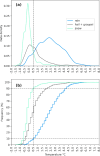Future changes of precipitation types in the Peruvian Andes
- PMID: 39349573
- PMCID: PMC11442656
- DOI: 10.1038/s41598-024-71840-2
Future changes of precipitation types in the Peruvian Andes
Abstract
In high-altitude regions, such as the Peruvian Andes, understanding the transformation of precipitation types under climate change is critical to the sustainability of water resources and the survival of glaciers. In this study, we investigate the distribution and types of precipitation on a tropical glacier in the Peruvian Central Andes. We utilized data from an optical-laser disdrometer and compact weather station installed at 4709 m ASL, combined with future climate scenarios from the CMIP6 project, to model potential future changes in precipitation types. Our findings highlight that increasing temperatures could lead to significant reductions in solid-phase precipitation, including snow, graupel and hail, with implications for the mass balance of Andean glaciers. For instance, a 2 °C rise might result in less than 10% of precipitation as solid, in regard to the present day, transforming the hydrological processes of the region. The two future climate scenarios from the CMIP6 project, SSP2-4.5 and SSP5-8.5, offer a broad perspective on potential climate outcomes that could impact precipitation patterns in the Andes. Our study underscores the need to revisit and expand our understanding of high-altitude precipitation in the face of climate change, paving the way for improved water resource management strategies and sustainable glacier preservation efforts in these fragile ecosystems.
Keywords: Climate change scenarios; High-altitude precipitation; Precipitation types.
© 2024. The Author(s).
Conflict of interest statement
The authors declare no competing interests.
Figures








References
-
- Harpold, A. A. et al. Rain or snow: hydrologic processes, observations, prediction, and research needs. Hydrol. Earth Syst. Sci.21, 1–22 (2017).
-
- Vuille, M. et al. Rapid decline of snow and ice in the tropical Andes - impacts, uncertainties and challenges ahead. Earth Sci. Rev.176, 195–213. 10.1016/j.earscirev.2017.09.019 (2018).
-
- Buytaert, W. et al. Glacial melt content of water use in the tropical Andes. Environ. Res. Lett.12, 114014. 10.1088/1748-9326/aa926c (2017).
-
- Viviroli, D. et al. Climate change and mountain water resources: Overview and recommendations for research, management and policy. Hydrol. Earth Syst. Sci.15, 471–504 (2011).
-
- Veettil, B. K. & Kamp, U. Global disappearance of tropical mountain glaciers: Observations, causes, and challenges. Geosciences9, 196 (2019).
Grants and funding
LinkOut - more resources
Full Text Sources

